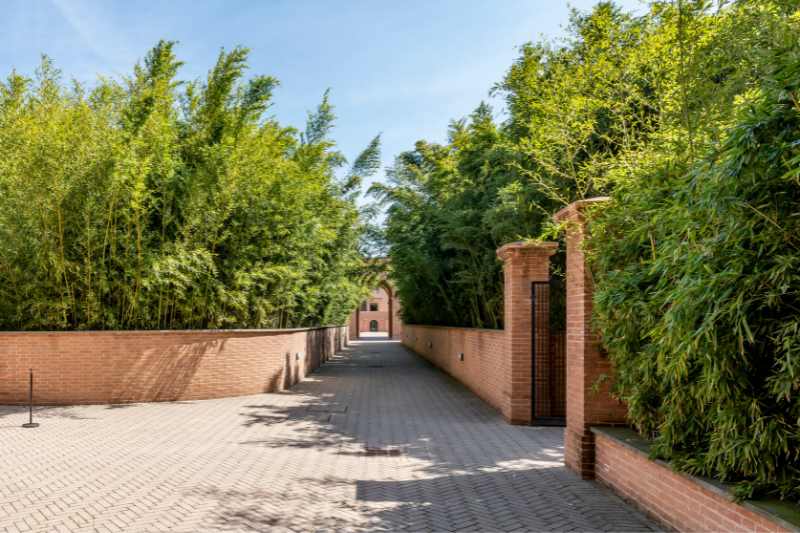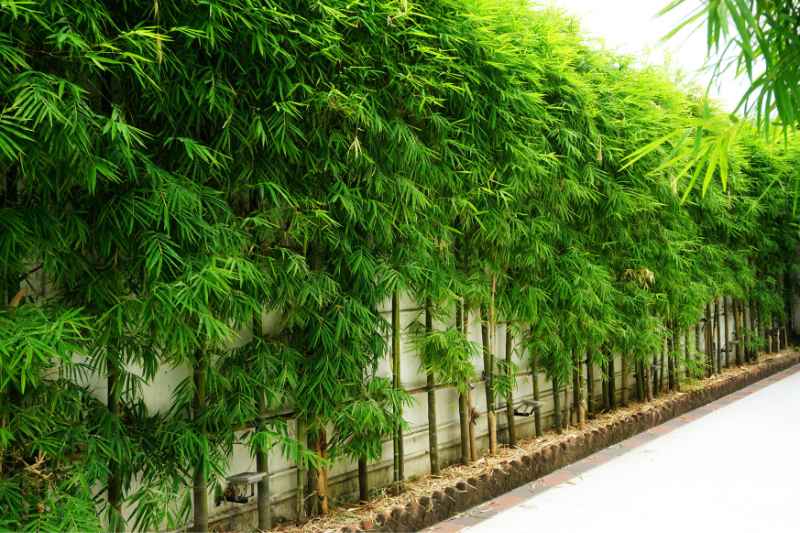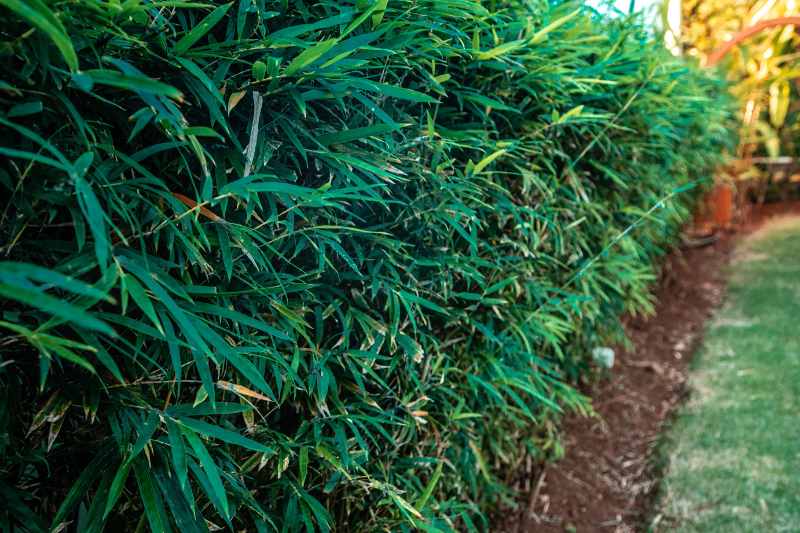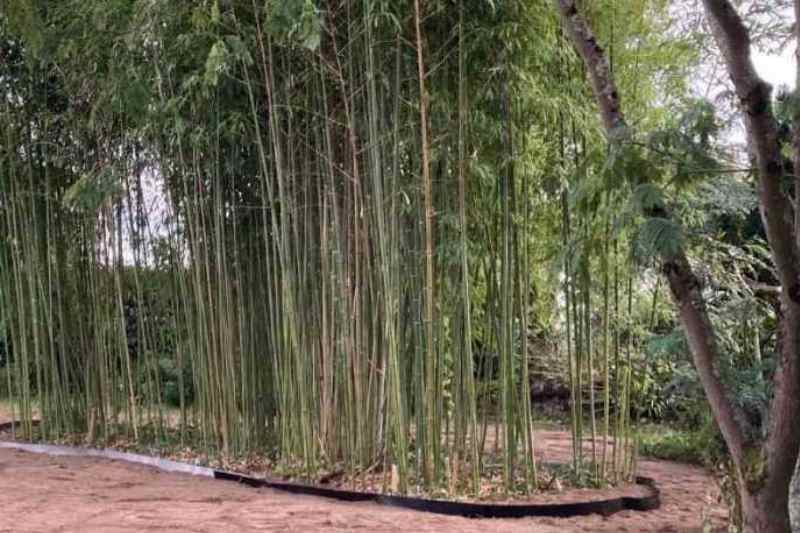Bamboo hedges offer a unique combination of natural beauty and robustness. With their rapid growth and dense foliage, they ensure perfect privacy while adding a touch of the exotic. Moreover, these hedges are remarkably resilient, providing a natural barrier against wind and noise. Let us guide you to create an oasis of tranquillity at home, with our expert advice on planting and maintaining a bamboo hedge.

First: choose the right variety
Choosing the appropriate bamboo variety is crucial to ensure success with your hedge. Bamboos are divided into two main categories: running bamboos and non-running bamboos. Running bamboos, such as Phyllostachys aureosulcata, are known for rapid growth and their ability to spread widely. They are ideal for quickly creating a dense hedge but require careful management to control their spread. In contrast, non-running bamboos, such as Fargesia murielae 'Simba', have a more contained growth habit, ideal for small gardens or for those who want a hedge that requires little maintenance in terms of rootstock control.
Your choice should also be influenced by the climate of your area. Some varieties, like Bambusa oldhamii (hardy down to -8 °C), thrive mainly in warm climates, while others, such as Phyllostachys nigra, are more cold-tolerant and can survive in more temperate environments. Also consider the space available: a running bamboo in a small garden will require constant maintenance to limit its spread, whereas a non-running bamboo will be more suitable and demand less effort to maintain its shape. Taking these aspects into account will help you choose the bamboo variety best suited to your hedge project.
Finally, there is the choice of mature size: some grow very tall, such as Fargesia papyrifera 'Blue Dragon', which can reach 6 m, while others are more modest, like Fargesia nitida 'Volcano', which will not exceed 2 m in height. Decide what hedge height you want.
To learn everything about growing bamboo, read Bamboo: planting, pruning and maintenance.
And before buying and planting bamboo, browse this excellent advice sheet titled Bamboo hedge: which variety to choose?

Choosing the location
Before planting your bamboo hedge, a key step is to choose its location carefully. Opt for a site that receives sufficient sunlight, taking into account wind direction and proximity to existing structures such as fences or buildings.
For running bamboos, spacing of 1 to 1.5 m between each plant will allow dense, rapid growth, forming a full hedge in little time. For non-running bamboos, spacing of 1.5 to 2 m is recommended, as these varieties tend to grow in more compact clumps. To estimate number of plants, divide total length of planned hedge by chosen spacing. For example, for a 15 m hedge with 1.5 m spacing, you will need about 10 plants.

When to plant bamboo?
Spring (March to May) is generally the ideal time to plant bamboo in temperate climates. The soil begins to warm, which favours good root establishment. Autumn (September to November) is also a good period, as the soil is still warm and there is usually more rainfall, which helps plants to establish.
However, in regions with harsh winters, it is preferable to plant in spring, once risk of frost has passed. Avoid late autumn planting, as plants may not have enough time to establish before frost arrives.
Soil preparation
Proper soil preparation is a determining factor for healthy, vigorous growth of your bamboo hedge. Start by thoroughly weeding the area where you plan to plant. It is essential to remove all weeds and debris to avoid competition for nutrients and water. Then dig or cultivate the soil to a depth of at least 30 to 40 centimetres to aerate it and facilitate penetration of bamboo roots.
Bamboo generally thrives in rich, well-drained and slightly acidic soil. To improve soil quality, incorporate organic amendments such as well-rotted compost or well-decomposed manure. These organic materials enrich the soil with nutrients, improve its structure and promote good moisture retention while ensuring adequate drainage. If your soil is naturally clayey or heavy, add coarse sand to improve drainage. In the case of overly acidic soils, dolomitic lime can be used to adjust pH.
For bamboo, ideal soil pH is between 6.0 and 6.5. If necessary, carry out a pH test to determine whether adjustments are required.

Planting bamboo
- Preparation of planting holes :
- Dig holes twice as wide as the bamboo rootball and slightly deeper.
- Ensure spacing between holes matches the spacing planned.
- Plant installation :
- Carefully remove bamboo plants from their containers to avoid damaging roots.
- Place each plant in its hole, ensuring the top of the rootball is level with the soil surface.
- Filling the holes :
- Fill holes with loosened soil, mixing with compost where possible to enrich the soil.
- Firm lightly around the base of the plant to remove air pockets.
- Initial watering :
- Water each plant thoroughly after planting to help establish contact between roots and soil.
- This watering also helps remove any remaining air pockets.
- Mulching :
- Apply a layer of organic mulch around the base of each plant. Mulch helps retain moisture, reduce weed growth and maintain a stable soil temperature.
- Care after planting :
- During the first weeks, monitor soil moisture and water regularly, especially during dry periods.
- Avoid chemical fertiliser immediately after planting to prevent burning young roots.

And the anti-rootstock barrier?
Installing an anti-rootstock barrier is a crucial element when creating a bamboo hedge, especially for running varieties that tend to spread rapidly. This barrier helps control rootstock growth, preventing bamboo from invading unwanted areas of your garden or those of neighbours.
- Choice of barrier :
- Opt for a resistant material such as high-density polyethylene, at least 2 mm thick.
- Barrier should be high enough, generally 60 to 70 cm, to prevent rootstock from passing over.
- Preparation of the trench :
- Dig a trench all around the planting area to a depth slightly greater than the barrier height.
- Trench must be wide enough to install the barrier comfortably.
- Installation of the barrier :
- Insert the barrier into the trench, ensuring it is vertical and stable.
- Leave a few centimetres of the barrier protruding above ground level to stop rootstock passing over.
- Securing the barrier :
- Use staples or pegs to secure the barrier to the soil so it remains in place.
- Ensure barrier joints are well sealed using strong adhesive tape or special clips for anti-rootstock barriers.
- Refilling the trench :
- Replace the soil around the barrier, tamping firmly to remove air pockets.
- Make sure there is no gap for rootstock to pass under the barrier.

Materials needed
- Spade : For digging planting holes.
- Anti-rootstock barrier or root barrier : Resistant material, such as high-density polyethylene, to limit rootstock propagation.
- Clips for barrier : For sealing edges of the anti-rootstock barrier.
- Staples or pegs : To secure the barrier to the soil.
- Measuring tape or garden line : For measuring and marking spacing between plants.
































Comments